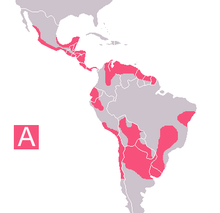Trypanosomiasis
Trypanosomiasis or trypanosomosis is the name of several diseases in vertebrates caused by parasitic protozoan trypanosomes of the genus Trypanosoma. In humans this includes African trypanosomiasis and Chagas disease. A number of other diseases occur in other animals.
| Trypanosomiasis | |
|---|---|
 | |
| Specialty | Infectious disease |
African trypanosomiasis, which is caused by either Trypanosoma brucei gambiense or Trypanosoma brucei rhodesiense, threatens some 65 million people in sub-Saharan Africa, especially in rural areas and populations disrupted by war or poverty. The number of cases has been going down due to systematic eradication efforts: in 1998 almost 40,000 cases were reported but almost 300,000 cases were suspected to have occurred; in 2009, the number dropped below 10,000; and in 2018 it dropped below 1000.[1] Chagas disease causes 21,000 deaths per year mainly in Latin America.[2]
Signs and symptoms
The tsetse fly bite erupts into a red chancre sore and within a few weeks, the person can experience fever, swollen lymph glands, blood in urine, aching muscles and joints, headaches and irritability. In the first phase, the patient has only intermittent bouts of fever with lymphadenopathy together with other non-specific signs and symptoms. The second stage of the disease is marked by involvement of the central nervous system with extensive neurological effects like changes in personality, alteration of the biological clock (the circadian rhythm), confusion, slurred speech, seizures and difficulty in walking and talking. These problems can develop over many years and if not treated, the person dies. It is common to the African continent.
Diagnosis
Cattle may show enlarged lymph nodes and internal organs. Haemolytic anaemia is a characteristic sign. Systemic disease and reproductive wastage are common, and cattle appear to waste away.
Horses with dourine show signs of ventral and genital edema and urticaria.
Infected dogs and cats may show severe systemic signs.
Diagnosis relies on recognition of the flagellate on a blood smear. Motile organisms may be visible in the buffy coat when a blood sample is spun down. Serological testing is also common.
Prevention
The use of trypanotolerant breeds for livestock farming should be considered if the disease is widespread.
Fly control is another option but is difficult to implement.
The main approaches to controlling African trypanosomiasis are to reduce the reservoirs of infection and the presence of the tsetse fly. Screening of people at risk helps identify patients at an early stage. Diagnosis should be made as early as possible and before the advanced stage to avoid complicated, difficult and risky treatment procedures.
Possible prevention
Trypanosomiasis could, in future be prevented by genetically altering the tsetse fly. As the tsetse fly is the main vector of transmission, making the fly immune to the disease by altering its genome could be the main component in an effort to eradicate the disease. New technologies such as CRISPR allowing cheaper and easier genetic engineering could allow for such measures. A pilot program in Senegal, funded by the International Atomic Energy Agency, has considerably reduced the tsetse fly population by introducing male flies which have been sterilized by exposure to gamma rays.[3]
Treatment
Stage I of the condition is usually treated with pentamidine or suramin through intramuscular injection or intravenous infusion if sufficient observation is possible. Stage II of the disease is typically treated with melarsoprol or eflornithine preferably introduced to the body intravenously. Both pentamidine and suramin have limited side effects. Melarsoprol is extremely effective but has many serious side effects which can cause neurological damage to a patient, however, the drug is often a patient's last hope in many late stage cases. Eflornithine is extremely expensive but has side effects that may be treated with ease.[4] In regions of the world where the disease is common eflornithine is provided for free by the World Health Organization.
Other animals

- Nagana, or animal African trypanosomiasis, also called 'Souma' or 'Soumaya' in Sudan.
- Surra
- Mal de cadeiras, or Quebra Bunda (of central South America, Brazil)
- Murrina de caderas (of Panama; Derrengadera de caderas)
- Dourine
- Cachexial fevers (various)
- Gambian horse sickness (of central Africa)
- Baleri (of Sudan)
- Kaodzera (Rhodesian trypanosomiasis)
- Tahaga (a disease of camels in Algeria)
- Galziekte, galzietzke (bilious fever of cattle; gall sickness of South Africa)
- Peste-boba (of Venezuela; Derrengadera)
Some species of cattle such as the African buffalo, N'dama, and Keteku appear trypanotolerant and do not develop symptoms. Calves are more resistant than adults.
References
- WHO. "Trypanosomiasis, Human African (sleeping sickness)". Fact sheet N°259. World Health Organization. Retrieved 25 February 2014.
- Maya JD, Cassels BK, Iturriaga-Vásquez P, et al. (2007). "Mode of action of natural and synthetic drugs against Trypanosoma cruzi and their interaction with the mammalian host". Comp. Biochem. Physiol., Part a Mol. Integr. Physiol. 146 (4): 601–20. doi:10.1016/j.cbpa.2006.03.004. PMID 16626984.
- Paquette, Danielle (2019-05-31). "A U.S.-funded nuclear project to zap a killer fly into extinction is saving West Africa's cows". The Washington Post. Retrieved 2019-06-01.
- Oxford Textbook of Medicine (Forth ed.). New York: Oxford University Press. 2003. pp. 770, 771.
Bibliography
- Thomas, H Wolferstan (1905). Report on trypanosomes, trypanosomiasis, and sleeping sickness : being an experimental investigation into their pathology and treatment. London: University Press of Liverpool. OCLC 11692559.
- Manson, Patrick (1914). Tropical diseases : a manual of diseases of warm climates (5th ed.). New York: William Wood. OCLC 812165069.
- Daniels, Charles Wilberforce (1914). Tropical Medicine and Hygiene. New York. OCLC 810109334.
- Maudlin, Ian; Holmes, Peter; Miles, Michael W (2004). The trypanosomiases. Wallingford, UK; Cambridge, Massachusetts: CABI Publishing. ISBN 9780851990347. OCLC 58543155.
External links
| Classification |
|---|
- Animal Trypanosomosis reviewed and published by Wikivet.
- Disease card on World Organisation for Animal Health